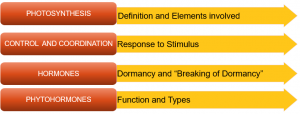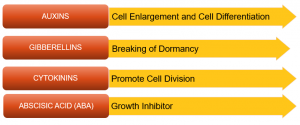Control and Coordination in Plants
Plants unlike Animal respond to different kind of Stimuli. Control and Coordination in Plants is based on the concept of movement.
Although this process involves Photosynthesis, control and coordination is based basically on the response of plants to stimuli which results in Growth.
Like Humans, Special Hormones are involved in the growth of a plant, that help it to react to a particular stimuli.

PHOTOSYNTHESIS
The process by which plants manufacture food in the presence of Sunlight, Water and Carbon Dioxide. This food that is stored is used by the plant in controlling and coordination the movement of the plant with the help of hormones, when they respond to a Stimuli. Movement in plants is based on the whole body of the Plant changing its position or direction based on the nature of the stimuli. Unlike Animals, they do not move single body parts in response to a stimulus.
For Coordination and functions to be carried out, there has to be control over the actions and reactions. Plants can change their behavior against environmental changes by the help of Hormones. As a result, Plants only use Hormones for Coordination and respond to stimuli by Growing.
DORMANCY AND BREAKING OF DORMANCY
When a Seed, before it develops into a seedling and then a Plant, it is in an sleeping or Dormant stage. It requires Warmth, Moisture, Air and Hormones to develop. This is known as Dormancy.
When the Seed acquires these elements, it then develops into a seedling, which then grows into a plant. The process by which the seed turned and transformed into a Plant, resulted in a process known as “Breaking of Dormancy”. This was done by the use of the elements acquired.
The sprouting of the seed into the Radicle (root) and Plumule (shoot), were all achieved by the help of hormones. The Plumule producing buds, leaves and flowers. All these took place in relation to a response to a stimuli with the help of hormones.
PHYTOHORMONES (Plant Hormones)
Phytos means “Light” as plants respond to sunlight for Growth.
Plant Hormones carry out the Control and Coordination in plants. They coordinate the plant activities by controlling the growth.
Apart from Growth, Other activities like Stomata Control, Formation of Flowers, Fruit Growth, Ripening of Fruits, Falling of Leaves, are all controlled by the action of Plant Hormones.
There are 4 types of Plant Hormones:
Auxins, Gibberellins, Cytokinins, Abscisic Acid (ABA)
TYPES OF PHYTOHORMONES

AUXINS
These promote Cell Enlargement and Cell Differentiation. They promote Fruit Growth. They Control a plants response to Light and Gravity. This means that they are Phototropic (help the shoot to respond to light and help it grow upwards towards light) and Geotropic (help the roots to grow down wards towards gravitational pull). They are produced on the tips of Stems and Roots. They are also used synthetically in Agriculture and Horticulture.
GIBBERELLINS
These like Auxins help promote Cell Enlargement and Cell Differentiation. They are responsible for the breaking of Dormancy in seeds and buds. They promote Fruit Growth and also help in the elongation of shoots.
CYTOKININS
These promote Cell Division. They delay the ageing in Leaves and the Breaking of Dormancy in Seeds and Buds. . They promote Fruit Growth and also help in the opening of the Stomata.
ABSCISIC ACID (ABA)
These function mainly a Growth Inhibitor. Unlike “Breaking of Dormancy”, ADA hormones help in the Dormancy of seeds and buds. They also help in the closing of Stomata and in the promotion of Wilting and Falling of Leaves. It also causes detachment of Flowers and Fruit
PLANT MOVEMENTS
Plants are always rooted or fixed to the ground. Hence, they cannot move from place to place like animals.
However, parts of the plant, shoot, flowers, fruits, leaves all respond to stimuli and move in that direction.
Plants responds to growth with the help of Auxins. Depending on the amount of Auxin present within the plant in a particular region, that portion of the plant will grow faster than the part with less Auxins. That is why plants bend.

TROPISMS OR TROPIC MOVEMENTS
The Growth movement of a plant in response to its stimulus, based on the direction of the stimulus, determines the direction of growth of the plant, referred to as TROPISM.
This Growth pattern of a plant can be based on the nature of the tropism. If the Plant bends or grows towards the stimulus, it has a positive effect on growth termed as Positive Tropism.
If the plant bends and grows away from the direction of stimulus, it has a negative effect on growth termed as Negative Tropism.

PHOTOTROPISM
This is the movement of the plant in response to light. This is a positive tropism, as the shoot of the plant grows towards sunlight.
GEOTROPISM
This is the movement of the plant in response to Gravity. This is a positive tropism, as the root of the plant grows downwards into the soil.
CHEMOTROPISM
This is when a plant responds to a Chemical. It too is a form of positive tropism. Eg the Pollen tube in a Flower grows toward the Ovules for Fertilization.
HYDROTROPISM
Roots always grow in the direction of the source of water for the development of the plant. In doing so they against the law of Gravity. They can grow upwards or sideways depending on the water source. They are said to be Hydrotropic.
THIGMOTROPISM
We may have come across situations or plants, that which upon touching close their leaves. Some plants have weak stems called Tendrils and use the support of stronger plants by winding around them and helping them grow. This is an example of positive tropism, as the weaker plant (tendril) responds to the stimulus by clinging and winding on it, enabling it to grow.
NASTIES OR NASTIC MOVEMENTS
When the response by a plant to a stimulus is ignored or not directed toward the stimulus, it is called a Nastic Movement.
Generally plants, their entire body, always grow in the direction of the stimulus. But in nastic movements, parts of the plant tend to behave differently, like the closing of Petals of a flower or the folding of the leaves. This behavior is called Thigmonasty
In certain cases, the petals of a flower open according to the intensity of light. The brighter the light, the petals remain open. If light fades, then the petals close. This behavior is called Photonasty.